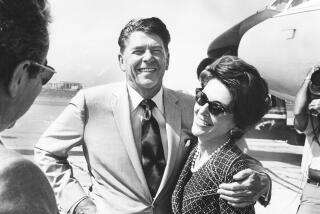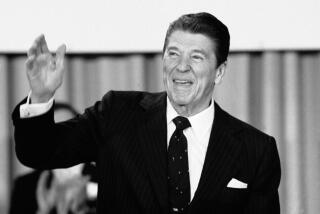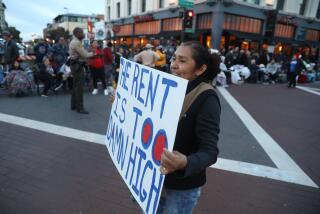Most Have Profited Under Reagan
In his 1980 presidential campaign, Ronald Reagan asked Americans to examine whether they were better off than four years earlier. As the 1988 presidential election approaches, similar questions will be posed.
The Republicans will point to the reduction in inflation, the lengthy economic expansion and relatively modest unemployment. The Democrats will point to the budget and trade deficits as well as the unevenness of gains in income and employment. In addition, they will raise the issue of fairness, alleging that Reagan’s policies have been unfair to the poor.
The President, Congress and Federal Reserve must share the credit or blame for the outcome of economic policy. In any case, the evidence shows that the fortunes of the poor and most other Americans have improved during the Reagan era.
For example, per-capita income (income after taxes, adjusted for inflation), consumption expenditures and median family income all have increased since Ronald Reagan assumed office: rising about 10%, 13.5% and 5%, respectively, from 1981 to 1986.
The poverty rate, or percentage of Americans living below the poverty line, has fallen to between 13% and 14%, about the level Reagan inherited. The rate peaked in 1983 at 15.2%, up from 11.7% in 1979. The severe 1981-82 recession temporarily worsened poverty, but the subsequent expansion has reduced it.
In addition, employment now exceeds 110 million, up from under 100 million in January, 1981. Likewise, the unemployment rate in April was 6.2%, the lowest since 1979, and below the 1976-80 average.
Moreover, the portion of the population working is at a peacetime high of 61%. Even though inflation is rising now, it is still far below the double-digit levels of 1980.
Not that the Reagan record is perfect. The federal government has been borrowing almost $2,000 per year per family, so economic gains, to some extent, have come at the expense of future taxpayers.
Also, structural changes in the economy, some aided by the President’s policies, have reduced income and job security for workers once protected from competition. For example, deregulation of the airlines has reduced salaries for some pilots, while opening job opportunities for others.
Partly as a result of federal budget deficits in the Reagan era, the dollar was sharply overvalued through 1985. That put tremendous pressure on industries and workers involved in international trade, including some that had offered high wages and job security.
Most of the subsequent plant closings in these industries, however, were inevitable. No economic policy can guarantee that every family’s income will remain stable or rise and that all jobs will be secure.
Most of the charges of unfairness hurled at Reaganomics cite tax law changes and budget cuts. The strident rhetoric of both Administration spokesmen and their opponents miss the point, however.
The tax reform act of 1986 removed 6 million poor families from the tax rolls.
Even though the top marginal tax rate is to be reduced to 28% in 1988--a change some critics call a giveaway to the rich--many wealthy people actually will pay higher taxes.
Further, the $120-billion corporate income tax increase over the next five years will be borne heavily by shareholders and owners of capital in general, who tend to be relatively wealthy. The overall effect of these tax changes is more populist than commonly perceived and will aid low-income and working-class people.
With its fiscal policy, the Reagan Administration indeed has shunned efforts to redistribute income and has played a more limited role in alleviating poverty and in cushioning temporary economic hardships. The rapid after-inflation growth of benefit payments to individuals in the 1960s and 1970s has been brought to a halt, except for Social Security.
The Reagan reforms aimed benefits much more directly to low-income families by tightening eligibility standards--an idea proposed, but never put into effect, by previous administrations.
The effectiveness of the Reagan programs is reflected by the share of benefits actually spent to reduce poverty rather than to increase the income of those above the poverty line. The figure rose from 44% in 1979 to 57% in 1984 for cash benefits and from 26% to 35% for in-kind benefits, such as food stamps and rent subsidies.
The most unfair element of the Reagan program--as well as those of its recent predecessors--has been its inability to do anything substantial about welfare for the rich. It failed to halt the growth of Social Security and Medicare benefits to the wealthy elderly or to halt the explosion in agricultural subsidies to wealthy absentee owners.
These programs now account for a bigger share of the federal budget.
The 1980s have been a time of extreme difficulty for agriculture, but the $2 million in agricultural subsidies paid to the Prince of Liechtenstein for land he owns in Texas hardly helped the poor.
Poverty has not been eliminated in the United States, but it has been reduced substantially. The reforms of the 1980s show that more cost-conscious and sharply focused programs are possible without destroying the social safety net.
The task for Reagan’s successor will be to continue the nation’s income gains without resorting to massive government borrowing. That task will be difficult, but reducing welfare for the rich is a better starting point than a major tax increase.
More to Read
Get the L.A. Times Politics newsletter
Deeply reported insights into legislation, politics and policy from Sacramento, Washington and beyond. In your inbox three times per week.
You may occasionally receive promotional content from the Los Angeles Times.










